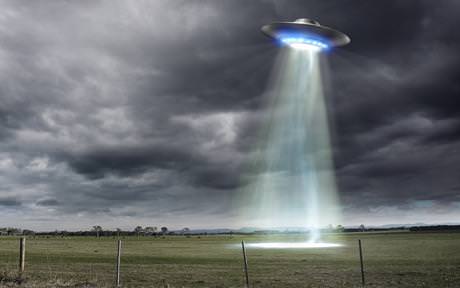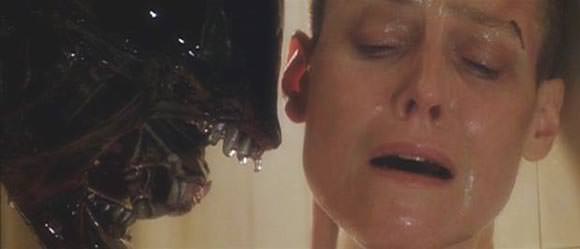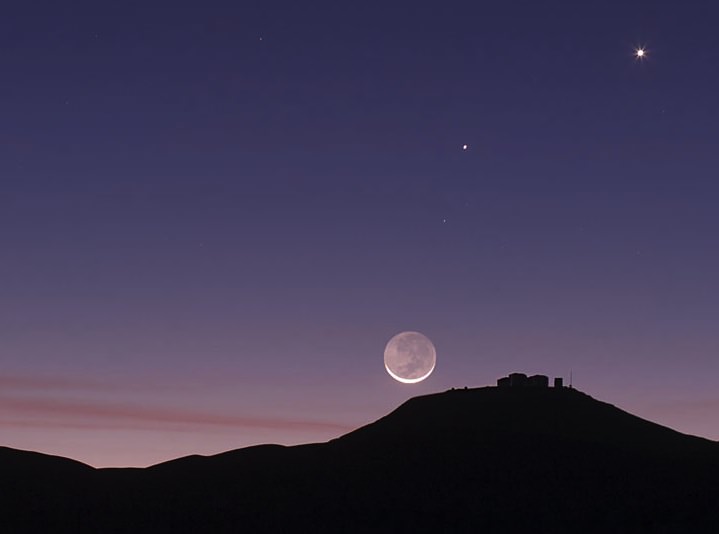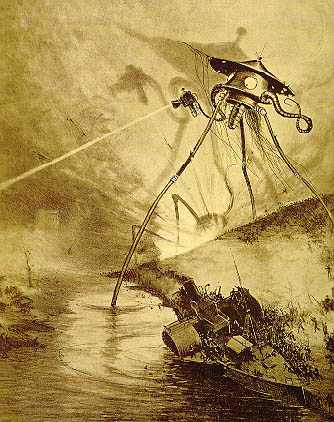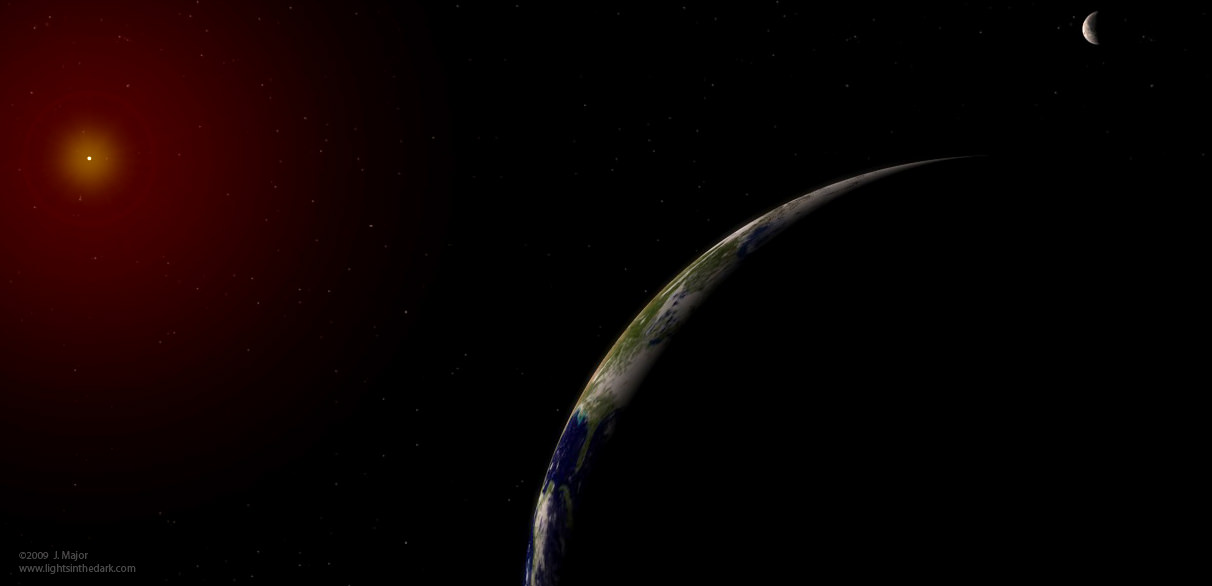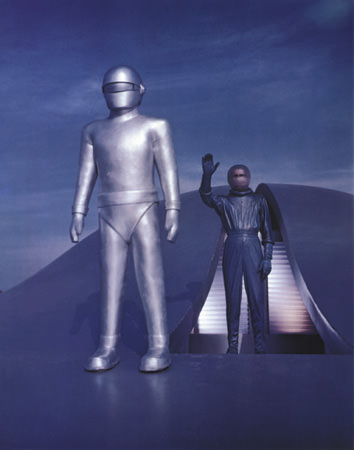Who knows what mysteries lurk at the military’s Area 51 complex in Nevada? Conspiracy theorists and UFO chasers think it’s a big alien coverup. But it’s probably something more boring, like advanced military aircraft. Let’s talk about what we know, and what we think we know about this infamous military base.
Continue reading “Astronomy Cast Ep. 346: Area 51”
Defiance: What Happens After Aliens Arrive
Wreckage, war and wrath are often the only results we see after aliens invade Earth, at least if you believe science fiction classics such as War of the Worlds. The new SyFy show Defiance, though, shows something a bit different: humans and aliens (Votans) trying to live side by side after the war.
Warning: minor spoilers ahead …
Now, this is no District 9. In 2046, the Votans roam around about as freely as the humans, although there’s a bit of ugly backstory that includes fighting and an uneasy truce. And no, this isn’t like Star Trek or Star Wars: the Votans and humans don’t work all that well together, at least not yet. Perhaps it’s too early in their history to think about it.
The show debuted on SyFy this month. Starring is Grant Bowler, previously of True Blood and Ugly Betty, as well as Dexter‘s Julie Benz.
“Nolan is an extreme pragmatist. He’s gone from war hero to scavenger and back again. He’s kind of the blunt instrument, if you like,” said Bowler of his human character in an NBC interview. Making things more interesting, Nolan has an alien adopted daughter and yes, they do actually get along (as well as most families do, anyway.)
When you have an hour on your hands, this one-hour discussion below about the show is well worth the watch. Don’t miss the part where Bowler talks about the challenge of working with “green screens”, which are essentially blank areas on set that are later filled with computer-generated graphics. Kind of disconcerting for an actor used to working on pre-arranged sets.
What other TV shows or movies featuring aliens can you recall that shows them living with humans after they get to Earth? Share them in the comments.
Poll: Obama Better Than Romney at Defending Earth from Alien Attack
Not quite sure this is really relevant or at all scientific, but nearly two in three Americans think President Barack Obama would be better than Republican rival Mitt Romney in dealing with an alien invasion, according to a poll done by the National Geographic Channel. Surely, this is in response to the claim that Obama was teleported to Mars as a youth to meet and greet the Martians living there.
In addition, disappointingly, 36% of Americans believe UFOs exist, and 11% claim they have actually seen one, and 20% said they know someone who has seen one, the poll also determined.
In May, the NGC contacted 1,114 adults across the United States to conduct an opinion poll for its new documentary series “Chasing UFOs.” The show premiers Friday with Texas and Colorado residents describing their encounters with mysterious flying objects. Hopefully there will be some science and reality behind this new series. The Houston Chronicle says the new series is a lot like the show “Finding Bigfoot,” and is by the same producers.
Groan.
Lead image caption: Artist concept of a UFO. Photo: Getty Images, via The Telegraph.
Source: Yahoo News
Aliens Don’t Want To Eat Us, Says Former SETI Director
[/caption]
Alien life probably isn’t interested in having us for dinner, enslaving us or laying eggs in our bellies, according to a recent statement by former SETI director Jill Tarter.
(Of course, Hollywood would rather have us think otherwise.)
In a press release announcing the Institute’s science and sci-fi SETIcon event, taking place June 22 – 24 in Santa Clara, CA, Tarter — who was the inspiration for Jodie Foster’s character in the film “Contact” — disagreed with both filmmakers and Stephen Hawking over the portrayal of extraterrestrials as monsters hungry for human flesh.
“Often the aliens of science fiction say more about us than they do about themselves,” Tarter said. “While Sir Stephen Hawking warned that alien life might try to conquer or colonize Earth, I respectfully disagree. If aliens were able to visit Earth that would mean they would have technological capabilities sophisticated enough not to need slaves, food, or other planets. If aliens were to come here it would be simply to explore.
“Considering the age of the universe, we probably wouldn’t be their first extraterrestrial encounter, either. We should look at movies like ‘Men in Black III,’ ‘Prometheus’ and ‘Battleship’ as great entertainment and metaphors for our own fears, but we should not consider them harbingers of alien visitation.”

Tarter, 68, recently announced her stepping down as director of SETI in order to focus on funding for the Institute, which is currently running only on private donations. Funding SETI, according to Tarter, is investing in humanity’s future.
“Think about it. If we detect a signal, we could learn about their past (because of the time their signal took to reach us) and the possibility of our future. Successful detection means that, on average, technologies last for a long time. Understanding that it is possible to find solutions to our terrestrial problems and to become a very old civilization, because someone else has managed to do just that, is hugely important! Knowing that there can be a future may motivate us to achieve it.”
On the other hand, concern that searching the sky for signs of life — as well as sending out your own — could call down hungry alien monsters would make a good case for keeping quiet. And a quiet search may not get the necessary funding to keep going. I can see where Tarter is coming from.
Let’s just hope she’s right. (About the eating part, at least.)
Top image: Alien 3, © 20th Century Fox. Tip of the tinfoil hat to EarthSky.org.
Is There Life on Earth?
[/caption]
It may seem like a silly question — of course there’s life on Earth — but what if we didn’t know that? What if we were looking at Earth from another vantage point, from another planet in another star system, perhaps? Would we be able to discern then if Earth were in fact teeming with life? All we’d have to go on would be the tiniest bit of light reflected off Earth, nearly lost in the intense glare of the Sun.
Researchers have found that the secret is knowing what kind of light to look for. And they discovered this with a little help from the Moon.
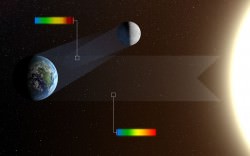
By using Earthshine — sunlight light reflected off Earth onto the Moon — astronomers with the European Southern Observatory have been able to discern variations that correlate with identifying factors of our planet as being a happy home for life.
In observations made with ESO’s Very Large Telescope (VLT), the presence of oceans, clouds, atmospheric gases and even plants could be detected in the reflected Earthshine.
The breakthrough method was the use of spectropolarimetry, which measures polarized light reflected from Earth. Like polarized sunglasses are able to filter out reflected glare to allow you to see clearer, spectropolarimetry can focus on light reflected off a planet, allowing scientists to more clearly identify important biological signatures.
“The light from a distant exoplanet is overwhelmed by the glare of the host star, so it’s very difficult to analyze — a bit like trying to study a grain of dust beside a powerful light bulb,” said Stefano Bagnulo of the Armagh Observatory, Northern Ireland, and co-author of the study. “But the light reflected by a planet is polarized, while the light from the host star is not. So polarimetric techniques help us to pick out the faint reflected light of an exoplanet from the dazzling starlight.”
Since we have fairly reliable proof that life does in fact exist on Earth, this provides astronomers with a process and a benchmark for locating evidence of life on other distant worlds — life as we know it, anyway.
Read more on the ESO website here.
Main image credit: ESO/B. Tafreshi/TWAN (twanight.org). This research was presented in a paper, “Biosignatures as revealed by spectropolarimetry of Earthshine”, by M. Sterzik et al. to appear in the journal Nature on 1st March 2012. The team is composed of Michael F. Sterzik (ESO, Chile), Stefano Bagnulo (Armagh Observatory, Northern Ireland, UK) and Enric Palle (Instituto de Astrofisica de Canarias, Tenerife, Spain).
Why Silicon-based Aliens Would Rather Eat our Cities than Us: Thoughts on Non-carbon Astrobiology
[/caption]
Editor’s note: Bruce Dorminey, science journalist and author of “Distant Wanderers: The Search for Planets Beyond the Solar System,” interviews NASA astrochemist Max Bernstein for Universe Today about the possibility of Silicon-based life.
Conventional wisdom has long had it that carbon-based life, so common here on earth, must surely be abundant elsewhere; both in our galaxy and the universe as a whole.
This line of reasoning is founded on two major assumptions; the first being that complex carbon chain molecules, the building blocks of life as we know it, have been detected throughout the interstellar medium. Carbon’s abundance appears to stretch across much of cosmic time, since its production is thought to have peaked some 7 billion years ago, when the universe was roughly half its current age.
The other major assumption is that life needs an elixir, a solvent on which it can advance its unique complex chemistry. Water and carbon go hand in hand in making this happen.
While the world as we know it runs on carbon, science fiction’s long flirtation with silicon-based life — “It’s life, but not as we know it” — has become a familiar catchphrase. But life of any sort should evolve, eat, excrete, reproduce, and respond to stimulus.
And although non-carbon based life is a very long shot, we thought we’d broach the issue with one of the country’s top astrochemists — Max Bernstein, the Research Lead of the Science Mission Directorate at NASA headquarters in Washington,D.C.
Bruce Dorminey — IS IT WRONG TO ASSUME THAT LIFE COULD BE BASED ON SOMETHING OTHER THAN CARBON?

Max Bernstein — It’s important for us to keep an open mind about alien life, lest we come across it and miss it. On the other hand, carbon is much better than any other element in forming the main structures of living things. Carbon can form many stable complex structures of great diversity. When carbon forms molecules containing cxygen and nitrogen, the carbon bonds to nitrogen and oxygen are stable. But not so much so that they can’t be fairly easily undone, unlike silicon-oxygen bonds, for example.
Dorminey — DOES THE RECENT NASA-FUNDED RESEARCH AT MONO LAKE, CALIFORNIA WHICH TOUTED THE DISCOVERY OF BACTERIA WITH DNA THAT USES ARSENIC INSTEAD OF PHOSPHORUS RATTLE THE CURRENT PARADIGM?
Bernstein — That was a really cool result, but the basic structure was still carbon. The arsenic was said to have replaced phosphorus, not carbon. The discovery of this putative arsenic organism may prove to be incorrect, but it’s a hypothesis with science behind it, and not just someone tossing out an idea and leaving it at the level of what if you replaced carbon with silicon?

Dorminey — SILICON SEEMS TO BE THE MOST POPULAR NON-CARBON BASED CANDIDATE, ARE THERE OTHERS THAT ALSO MIGHT BE FEASIBLE?
Bernstein — It’s hard to imagine anything that would be more likely that silicon because there is nothing closer to carbon than silicon in terms of its chemistry. It’s in the right place on the periodic table, just below carbon. On the face of it, [silicon-based life] doesn’t seem too absurd since silicon, like carbon, forms four bonds. CH4 is methane and SiH4 is silane. They are analogous molecules so the basic idea is that perhaps silicon could form an entire parallel chemistry, and even life. But there are tons of problems with this idea. We don’t see a complex stable chemistry [solely] of silicon and hydrogen, as we see with carbon and hydrogen. We use hydrocarbon chains in our lipids (molecules that make up membranes), but the analogous silane chains would not be stable. Whereas carbon-oxygen bonds can be made and unmade — this goes on in our bodies all the time — this is not true for silicon. This would severely limit silicon’s life-like chemistry. Maybe you could have something silicon-based that’s sort of alive, but only in the sense that it passes on information.
Dorminey — IF SILICON-BASED LIFE IS OUT THERE, HOW COULD WE EVER DETECT IT REMOTELY?
Bernstein — We are seriously arguing about how we would remotely detect life just like us, so I really couldn’t say. Presumably technology-using organisms, whatever their biochemistry, will produce technology, so the Search for Extraterrestrial Intelligence (SETI) may be our best shot.
Dorminey— HOW WOULD YOU LOOK FOR SILICON-BASED LIFE HERE ON EARTH?
Bernstein — When seeking an alien organism its really tough because you just don’t know what molecules to look for. One would have to be satisfied by something a bit more ambiguous, like sets of molecules that should not be there. For example, if you were an alien Silicon organism, you might not be looking for our biochemistry, but the fact that you kept seeing exactly the same chain lengths over and over again might tip you off to the fact that those darn carbon chains might actually be the basis of an organism’s membranes.
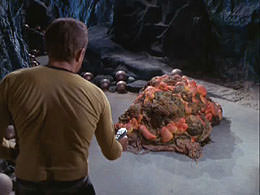
Dorminey — WHERE ARE THE LARGEST CONCENTRATIONS OF SILICON HERE?
IN SAND?
Bernstein — In sand or rock. There are literally megatons of silicate minerals on Earth.
Dorminey — HAS ANYONE EVER CLAIMED DETECTION OF SELF-REPLICATING EXAMPLES OF SILICON HERE ON EARTH?
Bernstein — There have been ideas about minerals holding information just as DNA holds information. DNA holds information in a chain that is read from one end to the other. In contrast, a mineral could hold information in two dimensions [on its surface]. A crystal grows when new atoms arrive on the surface, building layer upon layer. So, if a crystal sheet cleaved off and then started to grow that would be like the birth of a new organism and would carry information from generation to generation. But is a replicating crystal alive? To date, I don’t think that there is actually any evidence that minerals pass information like this.
Dorminey — IS THE CRUX OF THE PROBLEM THAT SILICON-BASED LIFE WOULD BE SO SLOWLY REPLICATING THAT IT COULD NEVER MAKE IT IN A DYNAMIC UNIVERSE?
Bernstein — I don’t think that any Silicon life form could be a biological threat to us. If they were high tech, they might eat our buildings or shoot guns at us but I don’t see how they could infect us. We run hot and move fast. If we don’t, things will catch us and eat us.
If they are also tougher than we are and whatever feeds on them is also slow and Silicon based maybe being slow doesn’t matter.
Dorminey — WHAT WOULD BE THE SIGNATURES OF SILICON-BASED LIFE?
Bernstein — If they are not technological, they would be very tough to detect. We could look for unstable, unexpected silicon molecules; some high energy molecule that should not be there, or molecular chains of all the same length.
Dorminey — DO YOU THINK THAT SILICON-BASED LIFE MIGHT EXIST SOMEWHERE OUT THERE?
Bernstein — Maybe deep below the surface of a planet in some very hot hydrogen-rich, Oxygen-poor environment, you would have this complex silane chemistry. There, maybe silanes would form reversible silicon bonds with selenium or tellurium.
Dorminey — IF SUCH SILICON-BASED LIFE DID CROP UP, WHAT WOULD BE ITS EVOLUTIONARY ENDGAME?
Bernstein — If it could evolve past the protist [microorganism] stage, then I think it could evolve intelligence. I have no idea how likely it is for intelligence to evolve, but I can believe in silicon crystals passing information from layer to layer or in silicon artificial intelligence, but I don’t expect to see silicon apes playing their equivalent of “Angry Birds” on their Silicon-Phones.
Dorminey — IF SILICON-LIFE DID EVOLVE, WOULD ITS LIFESPAN BE MUCH LONGER THAN ITS CARBON-BASED ANALOGUES?
Bernstein — The replicating mineral that I described earlier would be living very, very slowly on Earth’s surface. But maybe somewhere very much hotter, its lifespan would be shorter. That’s because presumably lifespan is connected to the pace of your chemistry, which depends on temperature.
Dorminey — FINALLY, WHAT WOULD ENDANGER NON-CARBON-BASED LIFE?
Bernstein — Physical harm for sure. Presumably you could take a jackhammer to it?
But our biochemistry would not be pathogens to it; we could not “infect” them as was the case in “War of the Worlds.”
No, NASA is Not Predicting We’ll be Destroyed by Aliens
[/caption]
There were some interesting, if not shocking headlines this week regarding a study supposedly put out by NASA, with the articles saying that aliens might come and destroy Earth because of our global warming problems. Headlines such as:
Aliens Could Attack Earth to End Global Warming, NASA Frets (Fox News)
Global Warming Could Provoke Alien Attack: NASA (International Business Times)
NASA: Aliens might destroy us because of our gases, (CNET)
and this one, which started the whole thing:
Aliens may destroy humanity to protect other civilizations, say scientists (The Guardian — The subheadline for this article originally said it was a NASA report, but has since been amended)
While the report is real, and one of the authors was a NASA intern, NASA in no way sponsored or endorsed the article, which was basically an enjoyable thought-experiment, and was titled: “Would Contact with Extraterrestrials Benefit or Harm Humanity? A Scenario Analysis.”
By comparing the title of the paper to the splashy headlines, as you can imagine, most of the news articles don’t accurately describe the paper’s content and conclusions — over-blowing just a tad the part about alien invasions — and the headlines portray NASA as being behind the paper and the research. But NASA didn’t really have a thing to do with the very speculative, if not fun paper.
After receiving some razzing from Keith Cowing at NASAWatch about how NASA just quietly allows the tabloids to determine the space agency’s public image, NASA used their social media presence to try and rectify the misconceptions. This morning @NASA twittered: Yes, @drudge & @guardiannews are mistaken about an “alien” report. It’s not NASA research. Ask the report’s author http://go.nasa.gov/nRI8Lf
Here’s the abstract from the paper: “While humanity has not yet observed any extraterrestrial intelligence (ETI), contact with ETI remains possible. Contact could occur through a broad range of scenarios that have varying consequences for humanity. However, many discussions of this question assume that contact will follow a particular scenario that derives from the hopes and fears of the author. In this paper, we analyze a broad range of contact scenarios in terms of whether contact with ETI would benefit or harm humanity. This type of broad analysis can help us prepare for actual contact with ETI even if the details of contact do not fully resemble any specific scenario.”
The paper was written by Seth Baum, Jacob Haqq-Misra, and Shawn Domagal-Goldman. Domagal-Goldman is a post-doc student working at NASA. Probably flustered, bewildered and a bit embarrassed, he wrote on NASA’s PaleBlue blog today to try and explain how this all got out of hand:
“So here’s the thing. This isn’t a “NASA report.” It’s not work funded by NASA, nor is it work supported by NASA in other ways. It was just a fun paper written by a few friends, one of whom happens to have a NASA affiliation.
A while ago, a couple good friends of mine (Seth Baum and Jacob Haqq-Misra) approached me about a paper they were writing, and asked if I wanted to join them on it. The paper was a review of all the different proposed situations for contact with an alien civilization. I didn’t think this was particularly important. After all, I consider the likelihood of contact with an alien civilization to be low. It certainly wasn’t urgent, as I don’t expect this to happen anytime soon. But… it sounded like fun and I decided to join in on it. So we wrote the paper, but I have to admit that Seth and Jacob put in the vast majority of the work on it. One of the scenarios we considered in the review was the possibility that an alien civilization would contact us because they were concerned about the exponential growth of our civilization, as evidenced by climate change. This isn’t an entirely new idea; remember, this was a review effort. Indeed, Keanu Reaves recently played a similar alien in the movie “The Day the Earth Stood Still.” There were lots of other ideas we reviewed, but this was probably the most provocative.
Well, the paper came out a couple months ago. Today, for some reason, The Guardian picked it up, publishing an article about it with the following title: “Aliens may destroy humanity to protect other civilizations, say scientist: Rising greenhouse emissions may tip off aliens that we are a rapidly expanding threat, warns a report for NASA.” That then was picked up by The Drudge Report, with this headline:
“NASA REPORT: Aliens may destroy humanity to protect other civilizations…”
UH OH. Now that is a bit problematic.
So here’s the deal, folks. Yes, I work at NASA. It’s also true that I work at NASA Headquarters. But I am not a civil servant… just a lowly postdoc. More importantly, this paper has nothing to do with my work there. I wasn’t funded for it, nor did I spend any of my time at work or any resources provided to me by NASA to participate in this effort. There are at least a hundred more important and urgent things to be done on any given work day than speculate on the different scenarios for contact with alien civilizations… However, in my free time (what precious little I have), I didn’t mind working on stuff like this every once in a while. Why? Well, because I’m a geek and stuff like this is fun to think about. Unfortunately, there is not enough time for fun. Indeed, I felt guilty at times because this has led to a lack of effort on my part in my interactions with Seth and Jacob. Beyond adding some comments here or there, I did very little for the paper.
But I do admit to making a horrible mistake. It was an honest one, and a naive one… but it was a mistake nonetheless. I should not have listed my affiliation as “NASA Headquarters.” I did so because that is my current academic affiliation. But when I did so I did not realize the full implications that has. I’m deeply sorry for that, but it was a mistake born out of carelessness and inexperience and nothing more. I will do what I can to rectify this, including distributing this post to the Guardian, Drudge, and NASA Watch. Please help me spread this post to the other places you may see the article inaccurately attributed to NASA.
One last thing: I stand by the analysis in the paper. Is such a scenario likely? I don’t think so. But it’s one of a myriad of possible (albeit unlikely) scenarios, and the point of the paper was to review them. But remember – and this is key – it’s me standing for the paper… not the full weight of the National Aeronautics and Space Administration. For anything I have done to mis-convey that to those covering this story, to the public, or to the fine employees of NASA, I apologize.”
Comet Elenin: Just Passing By
[/caption]
It starts out innocently enough: a small speck against a field of background stars, barely noticeable in the image data. But… it’s a speck that wasn’t there before. Subsequent images confirm its existence – there’s something out there. Something bright, something large, and it’s moving through our solar system very quickly. The faint blur indicates that it’s a comet, an icy visitor from the outermost reaches of the solar system. And it’s headed straight toward Earth.
Exhaustive calculations are run and re-run. Computer simulations are executed. All possibilities are taken into consideration, and yet there’s no alternative to be found; our world will face a close encounter with a comet in mere months’ time. Phone calls are made, a flurry of electronic messages fly between computer terminals across the world, consultations are held with top experts in the field. We are unprepared… what can we do? What does this mean for civilization as we know it? What will this speeding icy bullet from outer space do to our planet?
The answer? Nothing.
Nothing at all. In fact, it probably won’t even be very interesting to look at – if you can even find it when it passes by.
(Sorry for the let-down.)
There’s been a lot of buzz in the past several months regarding Comet Elenin, a.k.a. C/2010 X1, which was discovered by Russian astronomer Leonid Elenin on December 10, 2010. Elenin spotted the comet using a telescope in New Mexico remotely from his location in Lyubertsy, Russia. At that time it was about 647 million kilometers (401 million miles) from Earth… in the time since it has closed the distance considerably, and is now around 270 million km away. Elenin is a long-period comet, which means it has a rather large orbit around the Sun… it comes in from a vast distance, swings around the Sun and heads back out to the depths of the solar system – a round trip lasting over 10,000 years. During its current trip it will pass by Earth on October 16, coming as close as 35 million km (22 million miles).

Yes, 22 million miles.
That’s pretty far.
Way too far for us to be affected by anything a comet has to offer. Especially a not-particularly-large comet like Elenin.
Some of the doomy-gloomy internet sites have been mentioning the size of Elenin as being 80,000 km across. This is a scary, exaggerated number that may be referring to the size of Elenin’s coma – a hazy cloud of icy particles that surrounds a much, much smaller nucleus. The coma can be extensive but is insubstantial; it’s akin to icy cigarette smoke. Less than that, in fact… a comet’s coma and tail are even more of a vacuum than can be reproduced in a lab on Earth! In reality most comets have a nucleus smaller than 10km…that’s less than a billionth the mass of Earth (and a far cry from 80,000 km.) We have no reason to think that Elenin is any larger than this – it’s most likely smaller.
Ok, but how about the gravitational and/or magnetic effect of a comet passing by Earth? That’s surely got to do something, right? To Earth’s crust, or the tides? For the answer to that, I will refer to Don Yeomans, a researcher at NASA’s Near-Earth Object Program Office at JPL:
“Comet Elenin will not only be far away, it is also on the small side for comets. And comets are not the most densely-packed objects out there. They usually have the density of something akin to loosely packed icy dirt,” said Yeomans. “So you’ve got a modest-sized icy dirtball that is getting no closer than 35 million kilometers. It will have an immeasurably miniscule influence on our planet. By comparison, my subcompact automobile exerts a greater influence on the ocean’s tides than comet Elenin ever will.”
“It will have an immeasurably miniscule influence on our planet. By comparison, my subcompact automobile exerts a greater influence on the ocean’s tides than comet Elenin ever will.”
– Don Yeomans, NASA / JPL
And as far as the effect from Elenin’s magnetic field goes… well, there is no effect. Elenin, like all comets, doesn’t have a magnetic field. Not much else to say there.
But the claims surrounding Elenin have gone much further toward the absurd. That it’s going to encounter another object and change course to one that will cause it to impact Earth, or that it’s not a comet at all but actually a planet – Nibiru, perhaps? – and is on a collision course with our own. Or (and I particularly like this one) that alien spaceships are trailing Elenin in such a way as to remain undetected until it’s too late and then they’ll take over Earth, stealing our water and natural resources and turning us all into slaves and/or space munchies… or however the stories go. (Of course the government and NASA and Al Gore and Al Gore’s hamster are all in cahoots and are withholding this information from the rest of us. That’s a given.) These stories are all just that – stories – and have not a shred of science to them, other than a heaping dose of science fiction.
“We live in nervous times, and conspiracy theories and predictions of disaster are more popular than ever. I like to use the word cosmophobia for this growing fear of astronomical objects and phenomena, which periodically runs amuck on the Internet. Ironically, in pre-scientific times, comets were often thought to be harbingers of disaster, mostly because they seemed to arrive unpredictably – unlike the movements of the planets and stars, which could be tracked on a daily and yearly basis.”
– David Morrison, planetary astronomer and senior scientist at NASA’s Ames Research Center
The bottom line is this: Comet C/2010 X1 Elenin is coming, and it will pass by Earth at an extremely safe distance – 100 times the distance from Earth to the Moon. It will not be changing direction between now and then, it will not exert any gravitational effect on Earth, its magnetic field is nonexistent and there are no Star Destroyers cruising in its wake. The biggest effect it will have on Earth is what we are able to learn about it as it passes – after all, it is a visitor from the far reaches of our solar system and we won’t be seeing it again for a very, very long time.
I’m sure we’ll have found something else to be worried about long before then.
“This intrepid little traveler will offer astronomers a chance to study a relatively young comet that came here from well beyond our solar system’s planetary region. After a short while, it will be headed back out again, and we will not see or hear from Elenin for thousands of years. That’s pretty cool.”
– Don Yeomans
For more information about Elenin, check out this JPL news release featuring Don Yeomans, and there’s a special public issue of Astronomy Beat, a newsletter from the Astronomical Society of the Pacific, that features David Morrison of NASA’s Ames Research Center discussing many of the misconceptions about Elenin.
An updated chart of Elenin’s orbit and statistics can be viewed here.
Top image © Jason Major
FBI Memo Does Not Prove Aliens Crash Landed in Roswell
[/caption]
A 1950 FBI memo is creating some recent buzz by UFO supporters who say this provides “smoking gun” evidence that the US government recovered a crashed alien ship and bodies in Roswell, New Mexico in 1947. The memo, found on the FBI vault website and dated March 22, 1950 reports that an informant related information about three flying saucers had been recovered in New Mexico along with three bodies of human shape, but only 3 feet tall, and dressed in metallic cloth.
So, does this “newly found” and “secret” memo confirm what UFO supporters have believed for years, that the government covered up a landing by aliens in Roswell?
Sorry, no.
While the memo is genuine – written up by FBI special agent Guy Hottel, (you can see it on the FBI Vault website) it is not new, is not secret and does not have anything to do a supposed crash by an alien ship in Roswell, New Mexico.
The memo is not classified, as was reported by some websites, and has actually been discussed by UFO supporters for years, having been released in 1976 by the FBI. Even Robert Hastings, the guy who believes UFOs are shutting down nuclear reactors posted a comment on a UFO website that he has been discussing this memo in his talks since 1981.
So, the memo is certainly not new.
Also, the memo is not a secret FBI report, but a third-hand account from agent Hottel reporting what an Air Force investigator was told by an “informant.”
Lastly, as Benjamin Radford points out in his post on Live Science, “ the description in the memo of three ‘flying saucers…circular in shape with raised centers, approximately 50 feet in diameter,’ does not match the 1947 Roswell crash at all. Roswell eyewitnesses described finding lightweight metallic debris scattered in a field—not three intact 50-foot saucers holding nine dead alien bodies.”
In fact, Radford goes on, this memo does not refer to Roswell, but instead to a reported UFO crash in another small New Mexico town called Aztec in March 1948. The supposed crash was made famous by journalist Frank Scully who wrote for Variety magazine and wrote specifically about the Aztec crash in 1949. However, in 1952, it was revealed by another reporter that Scully had been hoaxed by a con man named Silas Newton, who fabricated the entire story in hopes of making money from the deal. Newton was arrested and convicted of fraud.
So, nothing new has been “revealed” by this old memo which very likely describes Newton’s account of an event that has since been proven to be a complete fabrication.
UN May Appoint Ambassador to Visiting Aliens
[/caption]
UPDATE: OK, this seemed like a cool story, reported by many news sources, but apparently, it isn’t true. The Discovery Discoblog has the details. . I guess there was a truth abduction.
If aliens ever visit Earth and actually do use the time-worn phrase, “Take me to your leader,” or if a SETI search ever finds a signal of an alien civilization saying “hello,” there may be someone ready and waiting to respond. The United Nations is considering selecting a special ambassador to be the first point of contact for aliens wishing to communicate with Earth. Mazlan Othman, a Malaysian astrophysicist and currently head of the UN’s Office for Outer Space Affairs (UNOOSA) is expected to be named to the position.
“Othman is absolutely the nearest thing we have to a ‘take me to your leader’ person,” said Richard Crowther, in an article in the UK newspaper, the Telegraph.
Crowther is an expert in space law at the UK space agency who leads delegations to the UN. Reportedly, the plan to make UNOOSA the coordinating body for dealing with alien encounters will be debated by UN scientific advisory committees and should eventually reach the body’s general assembly.
The proposal is said to have been prompted by the recent discovery of hundreds extrasolar planets, which makes the discovery of extraterrestrial life more probable than ever.
Ms. Othman said in a recent talk to fellow scientists, “The continued search for extraterrestrial communication, by several entities, sustains the hope that someday human kind will received signals from extraterrestrials. When we do, we should have in place a coordinated response that takes into account all the sensitivities related to the subject. The UN is a ready-made mechanism for such coordination.”
But will visiting ET’s be greeted with open arms, or with a conditional sterilization? Under the Outer Space Treaty written in 1967, (which UNOOSA oversees) UN members agreed to protect Earth against contamination by alien species by “sterilizing” them. Reportedly, Othman supports a more tolerant approach.
But physicist Stephen Hawking has warned that aliens should be treated with caution.
“I imagine they might exist in massive ships,” he said, “having used up all the resources from their home planet. The outcome for us would be much as when Christopher Columbus first landed in America, which didn’t turn out very well for the Native Americans.” Alien abduction would be the least of our worries.
In the meantime, US citizens wishing to be ‘ambassadors’ for space exploration should consider joining JPL’s Solar System Ambassador program. This is a great program (which I am honored to participate in) to spread the word about the wonders of excitement of space exploration and science. Find out more at the SSA website, and if interested, the program is now taking applications for new ambassadors. Hurry, as applications are being taken until September 30, 2010.
Source: The Telegraph


